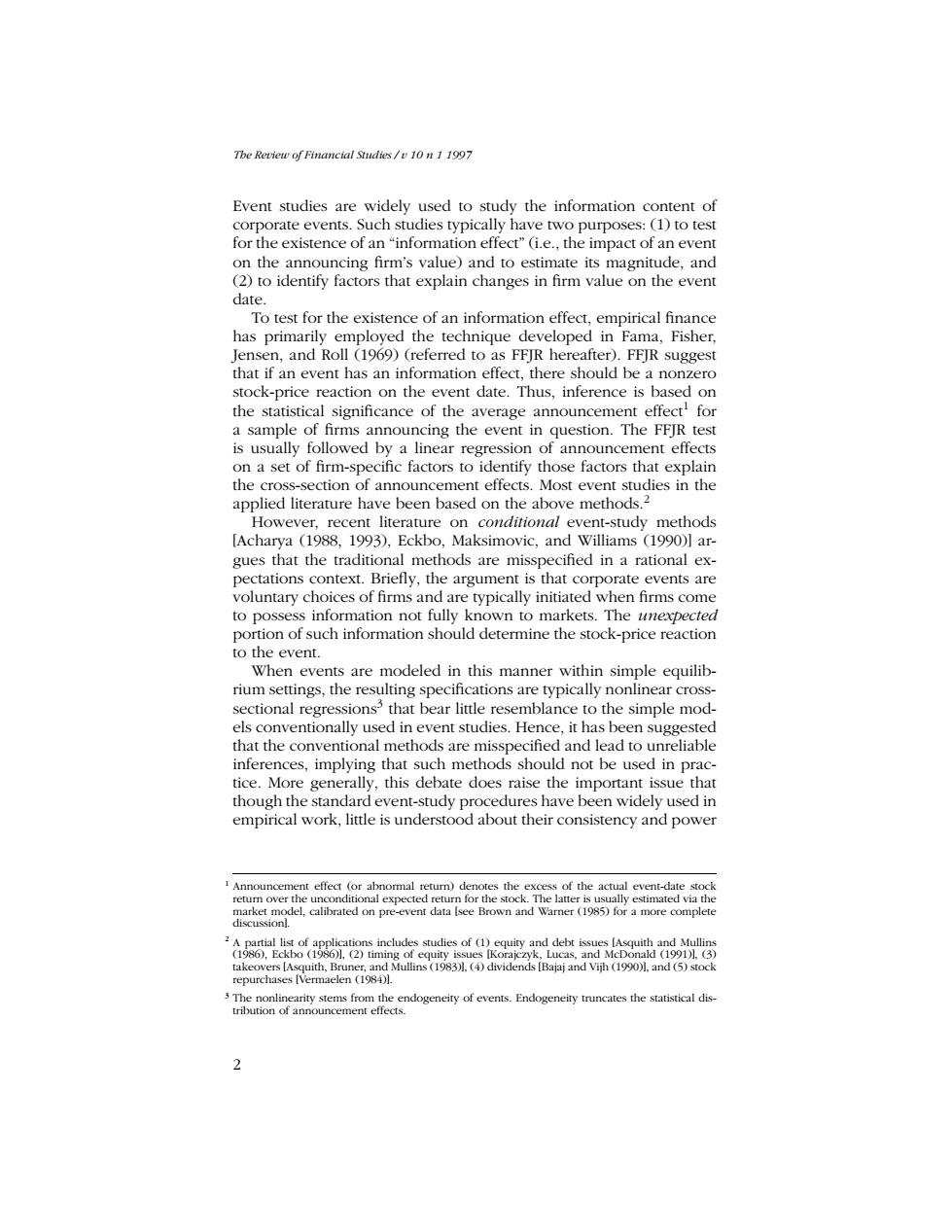正在加载图片...

The Review of Financial Studies /v 10 n 1 1997 Event studies are widely used to study the information content of corporate events.Such studies typically have two purposes:(1)to test for the existence of an "information effect"(i.e.,the impact of an event on the announcing firm's value)and to estimate its magnitude,and (2)to identify factors that explain changes in firm value on the event date. To test for the existence of an information effect,empirical finance has primarily employed the technique developed in Fama,Fisher, Jensen,and Roll (1969)(referred to as FFJR hereafter).FFJR suggest that if an event has an information effect,there should be a nonzero stock-price reaction on the event date.Thus,inference is based on the statistical significance of the average announcement effect for a sample of firms announcing the event in question.The FFJR test is usually followed by a linear regression of announcement effects on a set of firm-specific factors to identify those factors that explain the cross-section of announcement effects.Most event studies in the applied literature have been based on the above methods.2 However,recent literature on conditional event-study methods [Acharya (1988,1993),Eckbo,Maksimovic,and Williams (1990)]ar- gues that the traditional methods are misspecified in a rational ex- pectations context.Briefly,the argument is that corporate events are voluntary choices of firms and are typically initiated when firms come to possess information not fully known to markets.The unexpected portion of such information should determine the stock-price reaction to the event. When events are modeled in this manner within simple equilib- rium settings,the resulting specifications are typically nonlinear cross- sectional regressions3 that bear little resemblance to the simple mod- els conventionally used in event studies.Hence,it has been suggested that the conventional methods are misspecified and lead to unreliable inferences,implying that such methods should not be used in prac- tice.More generally,this debate does raise the important issue that though the standard event-study procedures have been widely used in empirical work,little is understood about their consistency and power Announcement effect (or abnormal return)denotes the excess of the actual event-date stock return over the unconditional expected return for the stock.The latter is usually estimated via the market model,calibrated on pre-event data [see Brown and Warner(1985)for a more complete discussionl. 2A partial list of applications includes studies of (1)equity and debt issues [Asquith and Mullins (1986),Eckbo (1986)1,(2)timing of equiry issues [Korajczyk,Lucas,and McDonald (1991)1,(3) takeovers [Asquith,Bruner,and Mullins (1983),(4)dividends [Bajaj and Vijh (1990),and (5)stock repurchases [Vermaelen (1984). 3The nonlinearity stems from the endogeneity of events.Endogeneiry truncates the statistical dis- tribution of announcement effects. 2The Review of Financial Studies / v 10 n 1 1997 Event studies are widely used to study the information content of corporate events. Such studies typically have two purposes: (1) to test for the existence of an “information effect” (i.e., the impact of an event on the announcing firm’s value) and to estimate its magnitude, and (2) to identify factors that explain changes in firm value on the event date. To test for the existence of an information effect, empirical finance has primarily employed the technique developed in Fama, Fisher, Jensen, and Roll (1969) (referred to as FFJR hereafter). FFJR suggest that if an event has an information effect, there should be a nonzero stock-price reaction on the event date. Thus, inference is based on the statistical significance of the average announcement effect1 for a sample of firms announcing the event in question. The FFJR test is usually followed by a linear regression of announcement effects on a set of firm-specific factors to identify those factors that explain the cross-section of announcement effects. Most event studies in the applied literature have been based on the above methods.2 However, recent literature on conditional event-study methods [Acharya (1988, 1993), Eckbo, Maksimovic, and Williams (1990)] argues that the traditional methods are misspecified in a rational expectations context. Briefly, the argument is that corporate events are voluntary choices of firms and are typically initiated when firms come to possess information not fully known to markets. The unexpected portion of such information should determine the stock-price reaction to the event. When events are modeled in this manner within simple equilibrium settings, the resulting specifications are typically nonlinear crosssectional regressions3 that bear little resemblance to the simple models conventionally used in event studies. Hence, it has been suggested that the conventional methods are misspecified and lead to unreliable inferences, implying that such methods should not be used in practice. More generally, this debate does raise the important issue that though the standard event-study procedures have been widely used in empirical work, little is understood about their consistency and power 1 Announcement effect (or abnormal return) denotes the excess of the actual event-date stock return over the unconditional expected return for the stock. The latter is usually estimated via the market model, calibrated on pre-event data [see Brown and Warner (1985) for a more complete discussion]. 2 A partial list of applications includes studies of (1) equity and debt issues [Asquith and Mullins (1986), Eckbo (1986)], (2) timing of equity issues [Korajczyk, Lucas, and McDonald (1991)], (3) takeovers [Asquith, Bruner, and Mullins (1983)], (4) dividends [Bajaj and Vijh (1990)], and (5) stock repurchases [Vermaelen (1984)]. 3 The nonlinearity stems from the endogeneity of events. Endogeneity truncates the statistical distribution of announcement effects. 2